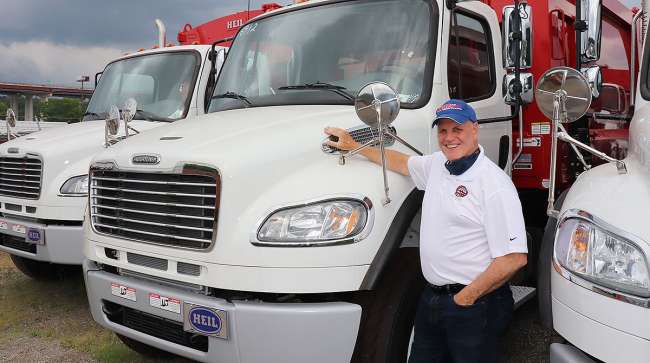Special to Transport Topics
Medium-Duty Market Rebounding Amid Virus Concerns

[Stay on top of transportation news: Get TTNews in your inbox.]
The medium-duty truck market has partially rebounded from the first months of the COVID-19 pandemic, and what happens next, analysts say, depends on the virus itself.
North American Classes 5-7 orders in June jumped 77% from May but were still down 20% from the previous year, according to a preliminary report issued by ACT Research earlier this month. June orders for medium- and heavy-duty vehicles were at a four-month high and were higher than orders in April and May combined.
The rebound followed sharp drops in previous months. Retail sales of Classes 5-7 vehicles fell 35% year-over-year in April and were down 37% in May, said Kenny Vieth, ACT president and senior analyst.

Vieth
Don Ake, vice president of commercial vehicles at research firm FTR, projected that with a modest recovery North American production in Classes 4-7 will be down 30% in 2020 versus last year, which is consistent with a recessionary year.
Ake forecasts the economy will improve during the third quarter. However, unemployment will remain high and consumer spending may not recover enough for medium-duty sales to significantly increase, he said.
“The way that I’m describing it to people is that it’s a climb back, not a snap back,” Ake said. “We’ve got to climb out of this, and based on the recent reports of the virus, this is going to take some time before the economy is back where people feel comfortable, where people are getting back out and the factories are producing uninterrupted.”
The only medium-duty category that saw growth during the shutdown was Class 5 delivery trucks because of e-commerce and home delivery services. Ake said it’s unknown how strong the e-commerce market for larger items will remain. Newly obtained trucks could be sufficient to meet demand.
An overbuild in 2019 led to a bloated inventory going into 2020, which helped counteract factory shutdowns.
The pandemic struck as sales were already softening cyclically. Even without the outbreak, ACT Research was projecting the medium-duty market would fall 10% and the heavy-duty market would drop 33% this year.
Vieth added that the economy contracted 30-35% in the second quarter at a seasonally adjusted rate. ACT expects the economy to grow 9% during the third quarter.
Although Vieth anticipates most of the pain will be concentrated in the second quarter, the recovery will take time. A truck is constructed from thousands of parts produced by hundreds of suppliers, and supply chains must be restarted safely.
Ake described the current economic climate as a “short, deep recession.” The recovery started in May after the economy hit bottom in April. Any growth means the recession is technically over, but the recovery continues.
His forecasters assume a middle path as the most likely pandemic scenario. They do not forecast scenarios where infection rates become much worse.
“Once you get into talking about the virus, you’re outside of the economics, and so yes that’s a possibility,” he said. “There’s no way to factor that into the forecast. The forecast has to assume that the pandemic will ease throughout the year and the economy will moderately improve throughout the year as a response.”
Fleets Take Cautious Approach
Some medium-duty truck buyers have adjusted their business strategies in response to the pandemic.

Penske
Penske’s leasing, rental and logistics operation manages 326,000 vehicles, including about 90,000 in Classes 5-7. When the pandemic hit, Penske went into a contractive position, said Paul Rosa, senior vice president of procurement and fleet planning. The company reduced its rental fleet by accelerating sales of some units. With some lease customers, it converted part of its rental fleet instead of providing new equipment.
Rosa said Penske is considering alternative scenarios. Infections could spike as schools and colleges reopen and sports resume. If students aren’t on campus, the medium-duty market will be affected. Some states are slowing their reopenings. He worries about a “W-shaped” recovery where a small improvement precedes another drop because of a spike in infections. Until those hurdles are cleared, many customers will be cautious.
Rosa said his hardest hit customers include those involved with electronics, home furnishings, appliances and clothing stores. Those sectors were down dramatically in April and the start of May and then started to rebound as the economy began to reopen.
Other sectors did well enough to offset the loss of business. Online services supported by the medium-duty segment saw a big boom in April and May and were strong in June. Medium-duty trucks used for building materials and home improvement stores did well because so many people were in their homes and doing home projects. Vocational and utility trucks, those involved in electrical repairs and those serving the medical field also remained in use.

Rosa
“Food and grocery stores, we couldn’t keep enough vehicles supporting them,” Rosa said.
Almost every segment of the medium-duty market was hit by the pandemic, though to varying degrees.
FTR’s Ake said beverage trucks had a short lull but probably will rebound by the end of the year. Refuse trucks and garbage trucks must be replaced eventually. Construction vehicles are doing surprisingly well and seem to be coming back because of low mortgage rates. City and state agencies may delay purchasing vehicles, depending on the recovery. Class 7 trucks connected with industrial uses will be weaker in the near-term and will recover over time, but it depends on the industry and how well the light manufacturing and industrial services sectors return.
Entergy, an electric utility serving customers in four southern states including Texas, said through a spokesperson that the pandemic hasn’t affected its Classes 5-8 truck purchasing and leasing decisions. The company operates 4,000 on-road vehicles including 1,700 medium duties. It is holding on to older units to support its social distancing efforts. The company said it has experienced significant delays with vehicles ordered from the manufacturer and expects additional delays at its upfitters.
According to ACT Research’s (ACT) latest State of the Industry: NA #Classes5-8 Report, May and June have returned to something closer to life as usual, following the shutdowns of March and April.https://t.co/6EX96uHOTK#truck #semitruck #trucking #transportation pic.twitter.com/nabOQvD3nH — ACT Research (@actresearch) July 20, 2020
The Class 8 market fell even further than the medium-duty market did, suffering drops of 50% year-over-year in April and 61% in May, ACT’s Vieth said. Class 8 tractor sales in May were down 71% year-over-year. In June, they rose 23.2% year-over-year, ACT said in its report.
Vieth said the heavy-duty market tends to have a 50% peak-to-trough cycle while medium duties have about half the volatility. The heavy-duty market has a more homogenous set of applications and large customers that buy many trucks at a time.
The medium-duty market is “just a wider, shallower puddle, so you’ve just got more economic niches buying vehicles to service their particular niche at a local level,” he said.
Penske’s Rosa said the medium-duty sector typically follows the heavy-duty sector: If Class 8s spike, then Classes 5-7 will later as the effect ripples through the supply chain. When Class 8s softened in July of last year, medium duties followed in October.
Dealers Begin to See Recovery
Two dealerships contacted for this story in mid-July said business had improved from the early days of the pandemic. Brian O’Donnell, principal of Valley Truck Centers serving parts of Ohio and Michigan, said July 10 that business “was starting to come back” from the early days when many customers put orders on hold for his dealership’s Freightliner, Western Star, Isuzu, Ford and Hino products. Manufacturers stopped building units for a 6- to 8-week period, but the federal government’s Paycheck Protection Program helped many customers weather the storm.
“It’s clearly not a V-shaped recovery or not even a U-shaped,” O’Donnell said. “At this point, we’re starting to look more like a little bit of a hockey stick that occasionally has a couple of bends in it back down. Once in a while, we’ll take a step back, but overall the sentiment is pretty positive recently in the past probably 3-4 weeks.”
By July 7, sales at Coffman Truck Sales in Aurora, Ill., which sells primarily Classes 5-7 Isuzus and Class 8 Volvos, had “basically turned into normal demand,” said Diane Zimmerman, general manager.
When the pandemic began, sales were “a dead stop,” she said. In the following months, the dealership moved some of its older used inventory because customers were being more careful and new models weren’t as readily available. As manufacturers returned to operation and more freight started moving, sales began to rebound at the beginning of June.
The company’s medium-duty customers include small business owners, landscapers, plumbers and electricians. Zimmerman said the hardest hit have been vending companies and higher-end residential suppliers. Her neighbor is a handyman whose summer was booked for deck installations, but he couldn’t obtain the lumber.
Zimmerman said parts would get stuck at suppliers when employees weren’t at work to complete the process, but the supplier’s computer would indicate the order had been fulfilled. That meant the dealership couldn’t cancel and reorder. Shortages occurred for parts coming from China and Mexico.
O’Donnell said his dealerships surprisingly never had a serious problem obtaining parts. A couple of manufacturers had issues getting parts from their Mexico-based facilities, but they have built up their warehouse stock.
Zimmerman said her dealership can’t predict what will happen with the pandemic, so it will “just keep making the next right step as we try to move forward through it.” But she’s optimistic about the future because everything people buy is transported by truck at some point.
O’Donnell cited concerns about the current surge in new infections. Inventory and parts have been depleted, so if manufacturers shut down again, shortages could occur.
Aside from that, he, too, is optimistic about the future. The pandemic led to greater efficiencies in the way his dealership does business, with more touch-free transactions, online parts sales, remote deliveries and remote service.
Many dealers see growth opportunities in Classes 5-7 sales with expedited freight and final-mile deliveries. Assuming the country gets through the current wave of infections relatively quickly, he believes the market will rebound toward the end of the third quarter.

Ake
“It’s going to be an off year,” O’Donnell said. “There’s no doubt about it. I mean, the percentage numbers are double digits off to our bottom line. That just is what it is. But for that third and fourth quarter, we think we can bring back a lot of that and minimize it, and the growth opportunities I think going into 2021 should give us some decent momentum.”
FTR’s Ake noted that trucking is no stranger to challenging times.
“Our industry is a tough industry, and it has tough people who [have] gone through a very tough time,” Ake said. “But again, these people have been through the cycles. Where other industries that haven’t been through the bad cycles, they may be panicking; people in our industry, I think, are going, ‘OK, this happened. Let’s get back to work. Let’s make it work.’ So I think that there’s optimism out there, and if the pandemic starts to fade away, I think that we’ll recover fine just like we always have.”
Want more news? Listen to today's daily briefing:
Subscribe: Apple Podcasts | Spotify | Amazon Alexa | Google Assistant | More




